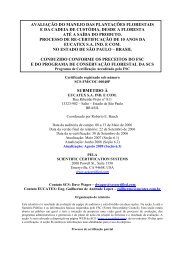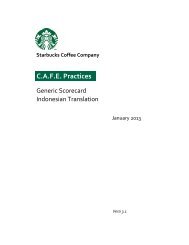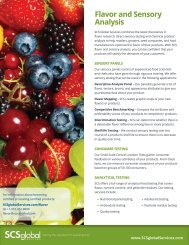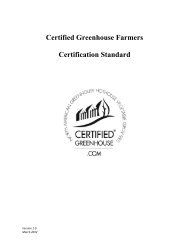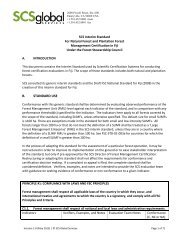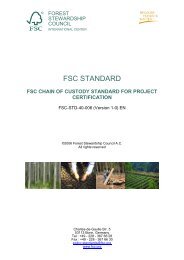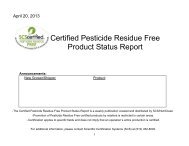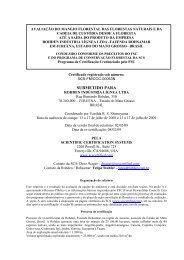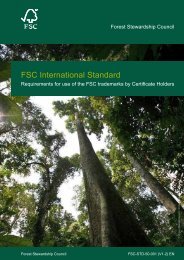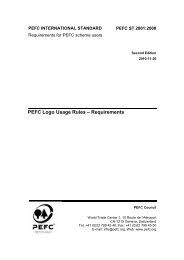CHAIN OF CUSTODY STANDARD - SCS Global Services
CHAIN OF CUSTODY STANDARD - SCS Global Services
CHAIN OF CUSTODY STANDARD - SCS Global Services
You also want an ePaper? Increase the reach of your titles
YUMPU automatically turns print PDFs into web optimized ePapers that Google loves.
CO 2 from sugarcane emitted in combustion and in ethanol fermentation is considered zeroCO 2 emission to the air, because this is the carbon taken in from the air during sugarcanegrowth. CO and VOCs emitted in combustion are assumed to be converted to CO 2 fairlyrapidly, but methane and nitrous oxides from burning bagasse are accounted for in GHGemissions. CO 2 emissions arising from biogenic carbon sources are excluded from thecalculation of GHG emissions from the life cycle of products, except where the CO 2 arisesfrom direct land use change. The greenhouse gases covered are CO 2, N 2 O and CH 4 .Methane and N 2 O have global warming potentials 23 and 296 times that of CO 2respectively (IPCC 2007). Greenhouse gas emissions are aggregated on a carbon dioxideequivalent (CO 2 eq) basis.Non-CO 2 emissions arising from both fossil and biogenic carbonsources are included in the calculation of GHG emissions. In the case of burning bagassein sugar mill boilers, it is assumed that 30 g CH 4 and 4 g N 2 O are produced per 1000 MJ ofenergy in the bagasse burnt, based on IPCC data for burning of biomass. Changes in thecarbon content of soils, either emissions or sequestration, other than those arising fromdirect land use change, are excluded from the assessment of GHG emissions. Any GHGemissions arising from transport required during the product and raw materials life cycleare included in the carbon footprint assessment. Emission factors for transport includeemissions associated with creating and transporting the fuels required.6. Calculation methodA materiality threshold of 1 % has been suggested to ensure that very minor sources of lifecycle GHG emissions do not require the same treatment as more significant sources.Both the energy usage and emissions are calculated in the same spreadsheet, since thelatter are largely determined by the former. The calculation includes the effects of themanufacture of fertilizer. Farming operations include chemicals application, irrigation,tillage and harvesting (and preparation of cane sets for planting). Cane transport coversgetting the cane to the mill. The cane is processed to sugar and molasses or ethanol, andmay include export of electric power or bagasse. The energy embedded in themanufacture of milling and other equipment is excluded. Inclusion of energy embedded incapital goods and equipment generally has an effect of less than 10 % on calculatedemissions and is excluded. No allowance for transport of products from the factory isallowed for. Transport of workers is not included.The primary energy is calculated. It differs from the direct energy input in that it takesinto account the efficiency of generation and supply of the secondary energy source e.g.using a conversion factor from energy in the fuel used to generate electricity to theenergy in the power produced. This applies to power, fuel, steam and any other energyinput.The GHG balance is particularly uncertain because of fertilizer nitrous oxide emissions anderror margins can be enormous. The use of nitrogen fertilizers results in GHG emissions intwo stages: fertilizer manufacture (primarily CO2 emissions from energy used) andfertilizer application (primarily N2O emissions from nitrification and denitrificationprocesses in the soil). The assumption is made that 1.325 % of N in nitrogen fertilizer isconverted to N in N2O through nitrification and denitrification, following the IPCCrecommendations.In addition, agricultural lime application results in GHG emissions from both productionenergy use and in-soil reactions that release CO2. These latter emissions are a furthersource of uncertainty. The model uses the IPCC factor of 0.44 kg CO2eq/kg lime, whichassumes that all C in lime becomes CO2. This is the upper limit; it is possible in weaklyacidic soils that limestone results in a net sink of CO2.Bonsucro Mass Balance ChoC Standard – Version 3.0 March 2011Including Bonsucro EU Mass Balance ChoC Standard© Bonsucro 2011/Bonsucro EU 2011Page | 19



